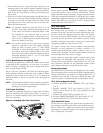
[6] Duct Smoke Detector Maintenance and Test
Procedures
Test and maintain duct smoke detectors as recommended
in NFPA 72. The tests contained in this manual were
devised to assist maintenance personnel in verification of
proper detector operation.
Before conducting these tests, notify the proper authorities
that the smoke detection system will be temporarily out of
service. Disable the zone or system under test to prevent
unwanted alarms.
[6.1] Smoke Entry Tests
[6.1.1] Air Flow
The DH100ACDCLP is designed to operate over an extended
air speed range of 100 to 4000 FPM. To verify sufficient
sampling of ducted air, turn the air handler on and use a
manometer to measure the differential pressure between
the two sampling tubes. The differential pressure should
measure at least 0.0015 inches of water and no more than
1.2 inches of water. Because most commercially available
manometers cannot accurately measure very low pressure
differentials, applications with less than 500 FPM of duct
air speed may require one of the following: 1) the use of
a current-sourcing pressure transmitter (Dwyer Series 607)
per Section 6.1.4 or; 2) the use of aerosol smoke per sec-
tion 6.1.2.
[6.1.2] Air Flow Test using Aerosol Smoke
This test is intended for low-flow systems (100-500 FPM).
If the air speed is greater than 500 FPM, use a conventional
manometer to measure differential pressure between the
sampling tubes, as described in 6.1.1.
Drill a
1
⁄4″ hole 3 feet upstream from the duct smoke detec-
tor. With the air handler on, measure the air velocity with
an anemometer. Air speed must be at least 100 FPM. Spray
aerosol smoke* into the duct through the
1
⁄4″ hole for five
seconds. Wait two minutes for the duct smoke detector to
alarm. If the duct smoke detector alarms, air is flowing
through the detector. Remove the duct smoke detector cover
and blow out the residual aerosol smoke from the chamber
and reset the duct smoke detector. Use duct tape to seal the
aerosol smoke entry hole.
*Aerosol smoke can be purchased from Home Safeguard Industries,
Malibu, CA. Phone: 310/457-5813.
[6.1.3] Smoke Entry Test
To determine if smoke is capable of entering the sens-
ing chamber, visually identify any obstructions. Plug the
exhaust and sampling tube holes to prevent ducted air from
carrying smoke away from the detector head, then blow
smoke such as cigarette, cotton wick, or punk directly at
the head to cause an alarm. REMEMBER TO REMOVE THE
PLUGS AFTER THIS TEST, OR THE DETECTOR WILL NOT
FUNCTION PROPERLY.
[6.1.4] Air Flow Test using Dwyer Series 607
Differential Pressure Transmitter
Verify the air speed of the duct using an anemometer. Air
speed must be at least 100 FPM. Wire the Dwyer transmit-
ter as shown in Figure 7. Connect the leads of the meter
to either side of the 1000Ω resistor. Allow unit to warm up
for 15 seconds. With both HIGH and LOW pressure ports
open to ambient air, measure and record the voltage drop
across the 1000Ω resistor (measurement 1), 4.00 volts is
typical. Using flexible tubing and rubber stoppers, connect
the HIGH side of the transmitter to the sampling tube of
the duct smoke detector housing, and the LOW side of the
transmitter to the exhaust tube of the duct smoke detec-
tor housing. Measure and record the voltage drop across
the 1000Ω resistor (measurement 2). Subtract the voltage
recorded in measurement 1 from the voltage recorded in
measurement 2. If the difference is greater than 0.15 volts,
there is enough air flow through the duct smoke detector
for proper operation.
Figure 7. Procedure for verifying air flow:
DIFFERENTIAL
PRESSURE
TRANSMITTER
MODEL #607-01
HIGH
LOW
TO SAMPLING TUBE
TO EXHAUST TUBE
VOLT METER
FLUKE MODEL 87
OR EQUIVALENT
1000 OHM 5% 1 WATT RESISTOR
9 VOL
T
BATTER
Y
9 VOL
T
BATTER
Y
9 VOL
T
BATTER
Y
15 TO 36VDC
SUPPL
Y
H0163-01
[6.1.5] Filter Replacement
The filters do not substantially affect smoke performance
even when up to 90% of the filter is clogged. Quarterly
visual inspection usually suffices to determine whether the
filters should be replaced because only a high percentage
of contamination affects performance. If further testing is
required, compare differential pressure readings with and
without the filters installed. If the difference exceeds 10%
replace the filters. In no case should the pressure differen-
tial fall below 0.0015 inches of water.
[6.2] Standby, Alarm and Sensitivity Tests
The cover must be removed to perform these tests. The use
of a remote accessory for visible indication of power and
alarm is recommended.
[6.2.1] Standby And Trouble
Standby — Look for the presence of the flashing green LED.
The LED should flash approximately every 10
seconds.
D200-14-00 5 I56-0084-08R










